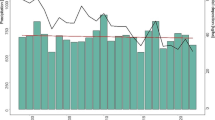Abstract
Copper sheeting is a common roofing material used in many parts of the world. However, copper dissolved from roof sheeting represents a source of copper ions to watersheds. Researchers have studied and recently developed a simple and efficient model to predict copper runoff rates. Important input parameters include precipitation amount, rain pH, and roof angle. We hypothesized that the length of a roof also positively correlates with copper concentration (thus, runoff rates) on the basis that runoff concentrations should positively correlate with contact time between acidic rain and the copper sheet. In this study, a novel system was designed to test and model the effects of roof length (length of roof from crown to the drip edge) on runoff copper concentrations relative to rain pH and roof angle. The system consisted of a flat-bottom copper trough mounted on an apparatus that allowed run length and slope to be varied. Water of known chemistry was trickled down the trough at a constant rate and sampled at the bottom. Consistent with other studies, as pH of the synthetic rainwater decreased, runoff copper concentrations increased. At all pH values tested, these results indicated that run length was more important in explaining variability in copper concentrations than was the roof slope. The regression equation with log-transformed data (R 2 = 0.873) accounted for slightly more variability than the equation with untransformed data (R 2 = 0.834). In log-transformed data, roof angle was not significant in predicting copper concentrations.
Similar content being viewed by others
References
Arnold, W. R. (2005). Estimations of copper roof runoff rates in the United States. Integrated Evironmental Assessment and Management, 1, 333–342.
Berner, E. K., & Berner, R. A. (1981). The global water cycle. Englewood Cliffs: Prentice-Hall.
Boulanger, B., & Nikolaidis, N. P. (2001). Contribution of copper-based architectural material to copper concentrations and toxicity in storm water runoff. Technical report. New York: Copper Development Association.
Boulanger, B., & Nikolaidis, N. P. (2003a). Mobility and aquatic toxicity of copper in an urban watershed. Journal of the American Water Resources Association, 39, 325–336.
Boulanger, B., & Nikolaidis, N. P. (2003b). Modeling framework for managing copper runoff in urban watersheds. Journal of the American Water Resources Association, 39, 337–346.
Faust, S. D., & Aly, O. M. (1981). Chemistry of natural waters. Ann Arbor: Ann Arbor Sciences Publishers.
Graedel, T. E. (1987). Copper patinas formed in the atmosphere, II: A qualitative assessment of mechanisms. Corrosion Science, 27, 721–740.
He, W. (2000). Corrosion rates and runoff rates of copper and zinc as roofing materials—A combined field and laboratory study. Licentiate thesis, Royal Institute of Technology Stockholm, Sweden.
Jolly, J. L. (2000). The U.S. copper-base scrap industry and its by-products: An overview. Technical report. New York: Copper Development Association.
Krätschemer, A., Wallinder, I. O., & Leygraf, C. (1997). The evolution of outdoor copper patina. Corrosion Science, 44, 425–450.
Landner, L., & Lindeström, L. (1999). Copper in society and in the environment: An account of the facts on fluxes, amounts and effects of copper in Sweden (2nd ed.). Västerås: Swedish Environmental Research Group (MFG).
Odnevall Wallinder, I., Bertling, S., Zhang, X., & Leygraf, C. (2004). Predictive models of copper runoff from external structures. Journal of Environmental Monitoring, 6, 704–712.
Sundberg, R. (1998). The fate of copper released from the Vasa shipyard museum. Metall, 52, 230–231.
Author information
Authors and Affiliations
Corresponding author
Rights and permissions
About this article
Cite this article
Bielmyer, G.K., Arnold, W.R., Tomasso, J.R. et al. Effects of roof and rainwater characteristics on copper concentrations in roof runoff. Environ Monit Assess 184, 2797–2804 (2012). https://doi.org/10.1007/s10661-011-2152-1
Received:
Accepted:
Published:
Issue Date:
DOI: https://doi.org/10.1007/s10661-011-2152-1




